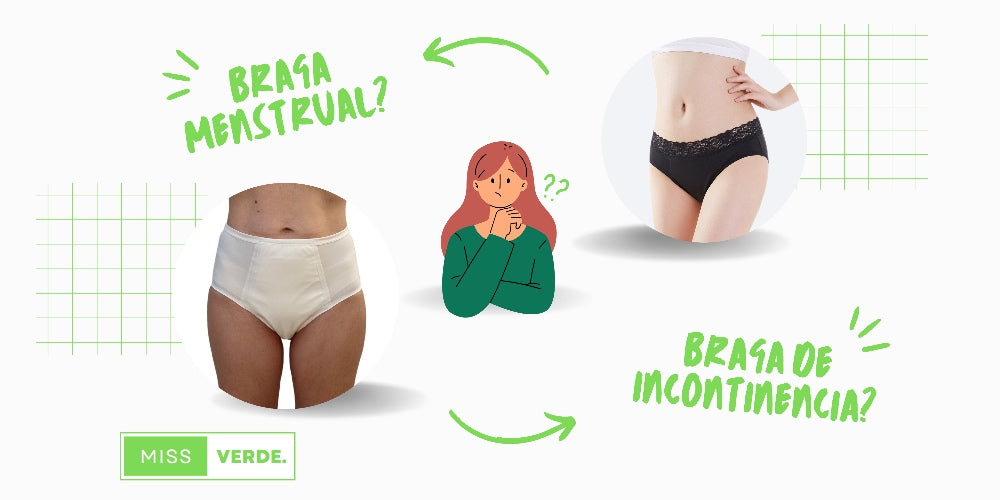
Period panties vs incontinence underwear: what are the differences?
Share
The popularity of menstrual underwear is largely due to the magic of this fantastic product. Composed of several layers made of different materials, there’s a layer that absorbs liquids and another that prevents leaks. Another reason is that it is a sustainable product that combats the ruinous environmental impact of single-use menstrual products.
Although the main purpose of menstrual panties is to support menstruating people during their periods, some users have discovered other uses for the product, using them as absorbent panties for incontinence: involuntary loss of urine.
This raised the question for MissVerde:
Can menstrual panties be used for incontinence?
To address this question it is crucial to understand the true nature of incontinence. There are different types of incontinence, each involving a different form of urine leakage. While we would like to address two problems at once, the reality is that menstruation and incontinence are two completely different things and should not be treated in the same way. This led us to reflect on whether the issue is not so much whether or not menstrual panties could be used for incontinence problems, but rather whether menstrual panties would help people with incontinence problems.
While it is true that both menstrual panties and incontinence underwear are made of absorbent materials to retain fluids, some important observations need to be made. The main difference between incontinence briefs and menstrual briefs is their function.
First of all, it is essential to take into account the differential factor is the type of liquids to be absorbed by each product, as this is essential for the correct management of menstruation or incontinence. For example, most people can hold more than 480 ml of urine in their bladder during the day. In comparison, during a menstrual period which typically lasts between 4-7 days, a woman normally produces between 60-80 millilitres of menstrual blood. This means that absorbent incontinence briefs must have a higher absorbency capacity than menstrual products to provide adequate protection.
Secondly, the outflow of menstrual blood from the body is considerably slower than the rapid flow of urine. Products intended for menstruation are designed to manage the slow release of menstrual blood. On the other hand, products designed for incontinence are created to manage the rapid flow of urine. Offering a product that can address both situations is challenging.
So; which product to use for urine leakage and which for menstruation?
It's a common question and, if you're one of the many women who wander down the feminine care aisle wondering which product to choose, we're here to help simplify it for you as we know it can be confusing. Many women who experience urine leakage are completely unaware that they are using the wrong product to treat their incontinence. At MissVerde, we want to help change this.
For the reasons mentioned above it can be concluded that menstrual panties are often not a good substitute for managing incontinence as they do not have the right level of absorbency or leakage barriers to control urine. When it comes to urinary incontinence, choosing the right product means finding the right product with the right features.
This is what to look for in incontinence underwear:
- Super absorbent core to keep rapid urine leakage under control.
- Top sheet that evacuates urine fast.
- Protection against urine leakage.
- Breathable materials to avoid skin irritation.
By way of comparison we would like to highlight the main differences between the absorbent capacity of a menstrual panty and an absorbent incontinence panty. As mentioned above, 60 to 80 ml of blood is usually lost during the menstrual week. In our shop, we offer the classic menstrual panty designed specifically for heavy flow, which has a 25ml capacity that is ideal for covering the heaviest days of your period. In comparison, our collection of absorbent underwear specially designed for incontinence has a capacity ranging from a minimum of 90ml to 200ml. This means that our absorbent incontinence briefs can hold at least 4x more fluid than a menstrual panty.
In our MissVerde shop you will also find products specially designed to protect you during the night. Our night time incontinence underwear has a higher absorbency area than our daytime incontinence underwear for total protection and a sound night's sleep without worrying or leaks.
Now that you know the difference between a menstrual panty and an incontinence panty, use the links below to find the best menstrual or incontinence products for the type of leakage you experience, as well as your size and absorbency needs.
